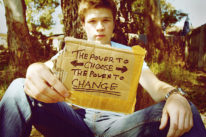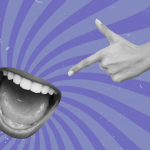
“If you let go a little, you will have a little happiness. If you let go a lot, you will have a lot of happiness. And if you let go completely, you will be completely happy.” ~Ajahn Chah
After accomplishing three lists of tasks from three different buckets—professional, personal, and entrepreneurial—I felt accomplished and content.
And then I felt bored. And then a little irritated. So, I decided to explore and check in with myself:
I practice gratitude throughout my day. I acknowledge the abundance in my life. I am surrounded by genuine love and relationships.
I have every reason to not wander away from happiness so easily, but I do. Why?
Perhaps you have experienced something similar: a moment of complete happiness, bliss, peace, and then it dissipates without notice.
I began by writing a series of questions in my journal to explore what was going on inside:
Is it because I can’t focus that I experience a deflation in my mood? Do I become bored too easily? Or maybe I have lack of patience that often leads to dissatisfaction?
Several pages later, I arrived at:
I can focus; but I am impatient, so I involve myself in multiple projects and events to even out the pace. When one project or event ends, I fully dive into the next to prevent boredom. During this gap of engagement, my mood shifts.
Further, I found comfort in moving around, connecting, accomplishing, engaging, clinging.
Clinging
This last word, clinging, reached out from the journal page and grabbed my attention.
After pages of self-inquiry and hours spent peeling back layers, I realized: my mood dip, this occasional creeping feeling of dissatisfaction did not result from anything I mentioned above.
Instead—this perceived lack of focus, the boredom, the impatience—were byproducts of my constant clinging. I was clinging to accomplishment, the next stimulating thing, the next anything in the future.I suspect that many of us, at some point in our day, can find ourselves clinging:
- We cling to old habits.
- We cling to daily comforts.
- We cling to pleasing others.
- We cling to the next vacation.
- We cling to a stubborn attitude.
- We cling to the love in a relationship.
- We cling to a perfection of how we should be.
- We cling to the security of a paycheck.
- We cling to memories of the past.
- We cling to the someday: the someday of when we reach retirement, or when we get that awesome job, or when something uncomfortable in our life passes.
We cling.
Often our clinging is to satisfy our ego—an attachment to prove to ourselves and the world that we are good enough. To prove that we are worthy. To prove that we are somebody special.
We each want to be heard, loved, and appreciated. So we attach ourselves to the needs of those feelings and, in turn, we seek out fulfillment by clinging to external outcomes.
It’s natural. It’s innate human behavior. We can choose otherwise, though.
Each day we are faced with a multitude of decisions, both large and small, as to whether we will choose to cling or choose to let go.
Each day we have the decision to choose the constant of peace or the erratic peaks and valleys of satisfaction and dissatisfaction.
Happiness
Realizing my clinging, I began to reflect on memories of when I experienced true happiness.
I found, in each these moments, there was no attachment. I was, simply, fully engulfed in the present.
My happiest memories included:
- When my husband and I brought home our first puppy. We took him to the park, flew a kite, and ran around for hours during a spring afternoon.
- The time I made colorful sunhats with a group of children, during a free fair at a low-income school.
- Exploring the rainforest for the first time, and feeling connected to the serenity of nature.
- Jogging at sunset, replenishing my body with energy.
- Giggling uncontrollably on the plane with girlfriends.
- Sitting at a cafe, writing, lost in the flow of creativity.
- Driving to yoga in the early morning, captivated by peace.
- Sharing a playful moment with my baby sister.
- Having a “BFF day” filled with fun, conversation and laughter.
- Simply, sitting in our backyard with a good book and the sun beaming down.
These memories had one common theme: a complete surrender to the present.
Clinging disconnects us from being here. When our mind clings to replaying the stories of the past or worrying about the future, we wander, and wander, and wander further away from the present, further away from happiness.
Choosing Happiness instead of Clinging
Gil Fronsdal is a teacher at Insight Meditation Center who has practiced Zen in the US since 1975. I often listen to his podcasts about finding peace through letting go. I’ve extracted a few main points to share with you.
Here are 4 ways to move away from clinging:
1. Know that clinging is a choice.
We have the ability to detach ourselves from what we believe should or should not happen. Clinging rarely helps any situation. Know that attaching yourself to a result or a person or a material item is always a choice—it is not required of any situation.
2. Ask yourself: What am I clinging to, and why?
Explore why you’re so pegged to a certain outcome. Or why you cling to a job, or a relationship, or a compulsion. Unpeel the layers behind the clinging to explore what is truly going on beneath them.
Maybe you cling to the comfort of an unhealthy relationship because of some false belief that you do not deserve better. Or you cling to over-committing at the office because you don’t fully enjoy your life outside your career. Or you cling to other people’s opinion or approval because you have not tuned into what you truly want. Or you cling to old habits because you fear the unknown of change.
We can explore what we are holding onto by probing within ourselves. Inquire by asking yourself questions: What am I clinging to, and why?
3. Understand the drawbacks of clinging.
Clinging detaches us from our ability to live freely. It removes us from the flow of creativity and flexibility. When we box ourselves in with expectations of a plan, we distract ourselves from seeing a grander picture. When we cling to expectations of people, desires, and situations, we become shortsighted.
4. Begin a mindfulness practice.
The best place to begin exploring your inner world and realize what you’re clinging to is to start a mindfulness meditation practice. A daily practice will help you develop self-awareness so you can acknowledge the clinging, inquire further, and let it go.
“A wonderful result of letting go is to experience each moment as being enough, just as it is. It allows us to be present for our experience here and now with such clarity and freedom that this very moment stands out as something profound and significant.” ~Gil Fronsdal
Parting Words
As I evolve into a deeper mindfulness practice, I become more aware that I cannot sustain happiness by clinging to externals.
Happiness is an ongoing practice. I’m learning to spend more time here, while reminding myself that happiness is a choice: I can choose to cling less to the past. I can choose to wander less to the future. I can choose to marvel more in the present.
What are your happiest moments? Do they also involve a complete surrender to the moment?
Photo by Camdiluv
About Cat Li Stevenson
Cat is an explorer of the human journey and a lover of well-being. She is living and practicing at an urban Zen Center in San Francisco, and working for Wisdom 2.0, an organization that strives to bring wisdom and awareness into the digital age. You can add her as a friend on FB or find her writing on Medium.













 Though I run this site, it is not mine. It's ours. It's not about me. It's about us. Your stories and your wisdom are just as meaningful as mine.
Though I run this site, it is not mine. It's ours. It's not about me. It's about us. Your stories and your wisdom are just as meaningful as mine.